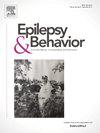动态脑电图(aEEG)在癫痫治疗中的独特地位
IF 2.3
3区 医学
Q2 BEHAVIORAL SCIENCES
引用次数: 0
摘要
目的(a)评估动态脑电图(aEEG)捕获癫痫发作/非癫痫事件的量(b)比较动态脑电图(aEEG)捕获间期癫痫样放电(IEDs)的量(c)评估动态脑电图(aEEG)在癫痫发作前≥2年无癫痫发作的抗癫痫药物(ASD)患者中的作用。方法对经aEEG治疗的患者在1.5年的时间内进行回顾性分析。“事件”被记录在日志中。收集的变量:年龄、性别、检查指征、癫痫发作频率、asd、aEEG和;以前的rEEG结果等。我们回顾了随访的临床记录,以记录aEEG结果的影响。结果纳入309例患者:(a) 10例(3%,只有2/10例(20%)记录了电图发作),14例发生非癫痫事件,而rEEG只有1例电图发作,无非癫痫事件;(b) IEDs的aEEG率为29%(88/309)。在88例aEEG患者中,59例既往rEEGs≥1,只有34/59捕获到ied,表明aEEG对ied的收率较高。25例rEEG正常的患者在aEEG上有ied (c) 22例ASD患儿要求aEEG。结果:癫痫发作2例(9%),罕见局灶性癫痫发作4例(18%),频繁局灶性癫痫发作/全面性癫痫发作各1例,非癫痫样aEEG 14例。在癫痫发作的患者中,asd没有被解除。频繁的简易爆炸装置。在4例罕见的ied中,2例(50%)断奶后癫痫复发,2例成功(无癫痫发作);1岁)断奶。14例非癫痫样脑电图中,3例(21%)断奶后复发;11例成功断奶。结论癫痫患者低估了癫痫发作负担。仅仅基于口头报告的临床决策可能会产生误导。aEEG可能有助于估计未识别的癫痫发作,并有助于指导ASD断奶决策。本文章由计算机程序翻译,如有差异,请以英文原文为准。
Unique place of ambulatory EEG (aEEG) in management of epilepsy
Purpose
(a) evaluate yield of ambulatory EEG (aEEG) for capturing seizures/non-epileptic events (b) compare aEEG yield in capturing Inter-ictal Epileptiform Discharges (IEDs) (c) evaluate aEEG role for Anti-Seizure Drug (ASD) wean in patients who were seizure-free for ≥ 2 years preceding aEEG.
Methods
Retrospective chart review was performed for patients who underwent aEEG over a specified time frame of 1.5 years. “Events” were documented on a log. Variables collected: age, sex, indication for test, seizure frequency, ASDs, aEEG & previous rEEG findings, etc. Follow-up clinic notes were reviewed to document impact of aEEG findings.
Results
309 patients were included: (a) Electrographic seizures captured in 10 (3 %, only 2/10 (20 %) were reported on log), 14 had non-epileptic events vs only 1 electrographic seizure on rEEG and no non-epileptic events (b) aEEG yield for IEDs was 29 % (88/309). Of 88 patients with aEEG, 59 also had also ≥ 1 prior rEEGs and only 34/59 captured IEDs indicating higher yield of aEEG for IEDs. 25 patients had a normal rEEG who then had IEDs on aEEG (c) aEEG was ordered for ASD wean in 22. Findings: seizures 2 (9 %), rare focal IEDs 4 (18 %), frequent focal/generalized IEDs 1 each, 14 nonepileptiform aEEG. ASDs were not withdrawn in patients with seizures & frequent IEDs. Of 4 with rare IEDs, 2 (50 %) had seizure recurrence after wean, 2 underwent successful (seizure-free > 1 year) wean. Of 14 with nonepileptiform EEG, 3 (21 %) had recurrence after wean & 11underwent successful wean.
Conclusions
Patients with epilepsy underestimate seizure burden. Clinical decision-making just based on verbal report can be misleading. aEEG may help provide estimation of unrecognized seizures and help guide ASD wean decision.
求助全文
通过发布文献求助,成功后即可免费获取论文全文。
去求助
来源期刊

Epilepsy & Behavior
医学-行为科学
CiteScore
5.40
自引率
15.40%
发文量
385
审稿时长
43 days
期刊介绍:
Epilepsy & Behavior is the fastest-growing international journal uniquely devoted to the rapid dissemination of the most current information available on the behavioral aspects of seizures and epilepsy.
Epilepsy & Behavior presents original peer-reviewed articles based on laboratory and clinical research. Topics are drawn from a variety of fields, including clinical neurology, neurosurgery, neuropsychiatry, neuropsychology, neurophysiology, neuropharmacology, and neuroimaging.
From September 2012 Epilepsy & Behavior stopped accepting Case Reports for publication in the journal. From this date authors who submit to Epilepsy & Behavior will be offered a transfer or asked to resubmit their Case Reports to its new sister journal, Epilepsy & Behavior Case Reports.
 求助内容:
求助内容: 应助结果提醒方式:
应助结果提醒方式:


